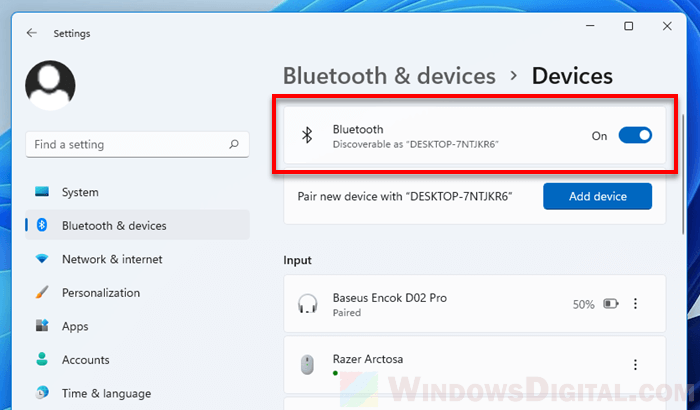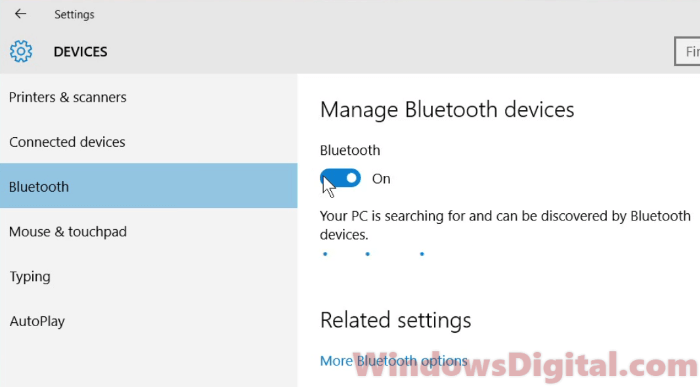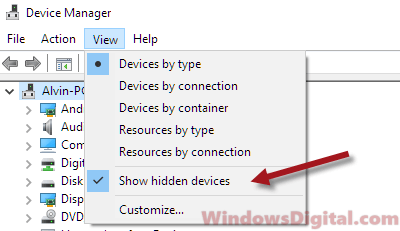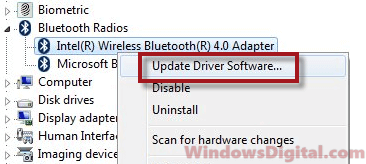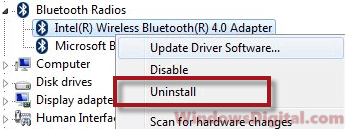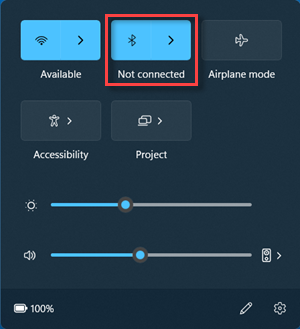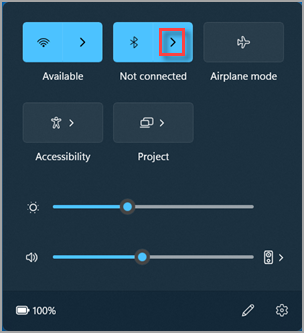- How to Turn On Bluetooth in Windows 11 or 10 Laptop
- Turn on Bluetooth in Windows 11/10
- No Bluetooth Toggle in Windows 10 or 11
- Check Bluetooth Generic Adapter
- Uninstall all Bluetooth adapter drivers
- Pair a Bluetooth device in Windows
- Turn on Bluetooth
- To pair a Bluetooth device
- To pair a Bluetooth printer or scanner
- To pair a Bluetooth device using Swift Pair
- Turn on Bluetooth
- To pair a Bluetooth headset, speaker, or other audio device
- To pair a Bluetooth keyboard, mouse, or other device
- To pair a Bluetooth printer or scanner
- To pair a Bluetooth device using Swift Pair
- Related topics
How to Turn On Bluetooth in Windows 11 or 10 Laptop
If your device supports Bluetooth functionality, such as a speaker, keyboard, or mouse, and your laptop or desktop is equipped with a Bluetooth adapter, you must enable Bluetooth in Windows 11 or 10 to connect the device.
This guide outlines the process for enabling Bluetooth in Windows 11/10 and offers troubleshooting tips for potential Bluetooth related issues. This guide is compatible with laptops from various manufacturers, including HP, Dell, Lenovo, Asus, Acer, and Toshiba.
Turn on Bluetooth in Windows 11/10
Before starting, ensure that you have a working built-in or USB Bluetooth adapter on your laptop or desktop PC, and that you have installed the required Bluetooth driver for your adapter. Some laptops have a hardware switch, usually with the function keys, to physically turn on the Bluetooth hardware on your laptop before it can be detected and used by Windows.
After ensuring that your Bluetooth adapter is working as intended, follow these steps:
For Windows 11:
- Press Win+i keys to open Settings app.
- Select Bluetooth & devices on the left pane.
- Beside the Bluetooth option, click on the toggle to turn it on if it’s not already “On”.
For Windows 10:
- Press Win+i keys to open Settings app.
- Select Devices.
- From the left pane, select Bluetooth.
- On the right, under Manage Bluetooth devices, click to toggle on the Bluetooth.
If Bluetooth is turned on, Windows should be able to discover your Bluetooth devices or be discovered by them. If you can’t see the Bluetooth option, or if there is no toggle beside it, it may indicate that Windows couldn’t detect any available Bluetooth adapter on your PC, or that the adapter has a problem. Check out this fix for more information: Bluetooth Not Working on Windows 11/10.
No Bluetooth Toggle in Windows 10 or 11
If you want to turn on or off your PC’s Bluetooth but can’t find the toggle option in the Windows settings, try the solutions below.
Check Bluetooth Generic Adapter
If the Bluetooth toggle in Windows 11/10 is missing from the Settings app, it most likely indicates that either the Bluetooth driver is not installed or is faulty. Here’s how to check if your Bluetooth adapter’s driver is correctly installed:
- Go to start menu.
- Search for and open Device Manager.
- Click View from the menu, then click Show hidden devices.
- Expand Bluetooth or Bluetooth Radios.
- If you see any Bluetooth adapter with a yellow exclamation mark beside it, it implies that the driver was not correctly installed.
Right-click on the Bluetooth adapter and select Update driver software. If you’re not sure which is your primary Bluetooth adapter, update all of them.After updating the driver, retry the steps above to turn on Bluetooth via the Windows settings. You should be able to see the toggle in the Bluetooth Settings if the driver is working as intended.
Uninstall all Bluetooth adapter drivers
If you have installed a faulty driver, you may want to try uninstalling all Bluetooth adapter drivers to allow Windows to automatically reinstall them. Windows has a feature that automatically installs missing drivers for your devices when it detects hardware that doesn’t have a driver.
To uninstall Bluetooth drivers via the Device Manager, follow the steps outlined above until step 4. Right-click the Bluetooth adapters from the list and select “Uninstall” to remove the driver. After rebooting your PC, the Bluetooth drivers should be installed automatically. You can then follow the instructions above for how to turn on Bluetooth on Windows 10 and see if the toggle is showing up in the Bluetooth settings.
It’s worth noting that some Bluetooth adapter drivers come with installed software. Therefore, you may also want to check the “Programs & Features” section to see if there is any Bluetooth-related software and uninstall it if you find any.
Pair a Bluetooth device in Windows
You can pair all kinds of Bluetooth devices with your PC—including keyboards, mice, phones, speakers, and a whole lot more. To do this, your PC needs to have Bluetooth. Some PCs, such as laptops and tablets, have Bluetooth built in. If your PC doesn’t, you can plug a USB Bluetooth adapter into the USB port on your PC to get it.
Before you start, make sure that your Windows 11 PC supports Bluetooth. For more info on how to check, see Fix Bluetooth problems in Windows. If you need help adding a device without Bluetooth capabilities, see Add a device to a Windows PC.
Turn on Bluetooth
After you’ve checked that your Windows 11 PC supports Bluetooth, you’ll need to turn it on. Here’s how:
- In Settings: Select Start >Settings >Bluetooth & devices , and then turn on Bluetooth .
- In quick settings: To find the quick setting for Bluetooth, select the Network, Sound, or Battery icons ( ) next to the time and date on the right side of your taskbar. Select Bluetooth to turn it on. If it’s turned on without any Bluetooth devices connected, it might appear as Not connected .
To pair a Bluetooth device
- Turn on your Bluetooth device and make it discoverable. The way you make it discoverable depends on the device. Check the device or visit the manufacturer’s website to learn how.
- On your PC, select the Network , Sound, or Battery icons ( ) next to the time and date on the right side of your taskbar.
- Select Manage Bluetooth devices on the Bluetooth quick setting, then select your device under New devices.
Your Bluetooth device and PC will usually automatically connect anytime the two devices are in range of each other with Bluetooth turned on.
Tip: If you don’t see the Bluetooth device you want displayed in the list, you may need to set the Bluetooth devices discovery setting to Advanced. To learn how, see Fix Bluetooth problems in Windows.
To pair a Bluetooth printer or scanner
- Turn on your Bluetooth printer or scanner and make it discoverable. The way you make it discoverable depends on the device. Check the device or visit the manufacturer’s website to learn how.
- Select Start >Settings >Bluetooth & devices >Printers & scanners >Add device. Wait for it to find nearby printers, choose the one you want to use, then select Add device.
If you’re having problems installing your printer or scanner, see either Fix printer problems or Install and use a scanner in Windows.
To pair a Bluetooth device using Swift Pair
Swift Pair in Windows 11 lets you quickly pair a supported Bluetooth device with your PC. If the Bluetooth device supports Swift Pair, you’ll receive a notification when it’s nearby and you put it into pairing mode to make it discoverable.
- Turn on a Bluetooth device that supports Swift Pair and make it discoverable. The way you make it discoverable depends on the device. Check the device or visit the manufacturer’s website to learn more.
- If this is your first time using Swift Pair, select Yes when asked if you want to get notifications and use Swift Pair.
- When a notification appears that a new Bluetooth device was found, select Connect.
Before you start, make sure that your Windows 10 PC supports Bluetooth. For more info on how to check, see Fix Bluetooth problems in Windows 10. If you need help adding a device without Bluetooth capabilities, see Add a device to a Windows 10 PC.
Turn on Bluetooth
After you’ve checked that your Windows 10 PC supports Bluetooth, you’ll need to turn it on. Here’s how:
In Settings: Select Start > Settings > Devices > Bluetooth & other devices, and turn on Bluetooth.
In action center: Action center can be found next to time and date on your taskbar. On the taskbar, select action center ( or ), then select Bluetooth to turn it on. If it’s turned off, it might appear as Not connected.
If you don’t see Bluetooth in your action center, here’s how you can change it:
- Expand quick actions. On the taskbar, select action center ( or ) >Expand. Bluetooth should appear here. It will appear as Bluetooth or Not connected.
- Add Bluetooth to action center. Select Start >Settings >System >Notifications & actions >Quick actions. Go to Add or remove quick actions and turn on Bluetooth.
Note: For more info about how to change the apps and settings that appear in action center, see Change notification and action settings in Windows 10.
To pair a Bluetooth headset, speaker, or other audio device
- Turn on your Bluetooth audio device and make it discoverable. The way you make it discoverable depends on the device. Check the device or visit the manufacturer’s website to learn how.
- On your PC, select Start >Settings >Devices >Bluetooth & other devices >Add Bluetooth or other device >Bluetooth. Choose the device and follow additional instructions if they appear, then select Done. Your Bluetooth device and PC will usually automatically connect anytime the two devices are in range of each other with Bluetooth turned on.
To pair a Bluetooth keyboard, mouse, or other device
- Turn on your Bluetooth keyboard, mouse, or other device and make it discoverable. The way you make it discoverable depends on the device. Check the device or visit the manufactur’s website to learn how.
- On your PC, select Start >Settings >Devices >Bluetooth & other devices >Add Bluetooth or other device >Bluetooth. Choose the device and follow additional instructions if they appear, then select Done.
To pair a Bluetooth printer or scanner
- Turn on your Bluetooth printer or scanner and make it discoverable. The way you make it discoverable depends on the device. Check the device or visit the manufacturer’s website to learn how.
- Select Start >Settings >Devices >Printers & scanners >Add a printer or scanner. Wait for it to find nearby printers, then choose the one you want to use and select Add device.
If you’re having installation issues with your printer or scanner, see either Fix printer problems or Install and use a scanner in Windows 10.
To pair a Bluetooth device using Swift Pair
Swift Pair in Windows 10 lets you quickly pair a supported Bluetooth device with your PC. If the Bluetooth device supports Swift Pair, you’ll receive a notification when it’s nearby and you put it into pairing mode to make it discoverable.
- Turn on a Bluetooth device that supports Swift Pair and make it discoverable. The way you make it discoverable depends on the device. Check the device or visit the manufacturer’s website to learn more.
- If this is your first time using Swift Pair, select Yes when asked if you want to get notifications and use Swift Pair.
- When a notification appears that a new Bluetooth device was found, select Connect.
- After it’s connected, select Close.
Tip: If you’re a small business owner looking for more information on how to get Microsoft 365 set up, visit Small business help & learning.
